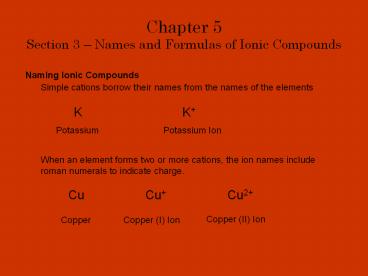Chapter 5 Section 3 - PowerPoint PPT Presentation
Title:
Chapter 5 Section 3
Description:
... chloride ZnS zinc sulfide Mg3N2 magnesium nitride K2O potassium ... Acetate AuSCN Cesium Ion Fe(NO3)3 Titanium (II) Thiosulfate Sb2(CO3)5 Zirconium ... – PowerPoint PPT presentation
Number of Views:75
Avg rating:3.0/5.0
Title: Chapter 5 Section 3
1
Chapter 5 Section 3 Names and Formulas of
Ionic Compounds
Naming Ionic Compounds
Simple cations borrow their names from the names
of the elements
K K
Potassium
Potassium Ion
When an element forms two or more cations, the
ion names include roman numerals to indicate
charge.
Cu Cu Cu2
Copper (II) Ion
Copper
Copper (I) Ion
2
Chapter 5 Section 3 Names and Formulas of
Ionic Compounds
The name of a simple anion is also formed from
the name of the element, but it ends in -ide
Br Br-
Bromine
Bromide
The Names of Ions Are Used to Name an Ionic
Compound
Naming binary ionic compounds is simple. The name
is made up of just two words the name of the
cation followed by the name of the anion. NaCl
sodium chloride CuCl2 copper(II) chloride ZnS
zinc sulfide Mg3N2 magnesium nitride K2O
potassium oxide Al2S3 aluminum sulfide
3
Chapter 5 Section 3 Names and Formulas of
Ionic Compounds
Polyatomic Ions
The adjective simple describes an ion formed from
a single atom. A simple ion could also be called
monatomic, which means one-atom. Just as the
prefix mon- means one, the prefix poly- means
many. The term polyatomic means a charged group
of two or more bonded atoms that can be
considered a single ion. A polyatomic ion as a
whole forms ionic bonds in the same way that
simple ions do.
The Names of Polyatomic Ions Can Be Complicated
Naming polyatomic ions is not as easy as naming
simple cations and anions. Even so, there are
rules you can follow to help you remember how to
name some of them. However you will not have to
know these rules. Your Reference Table has all of
the polyatomic ions that you are responsible to
use listed on table E on the front page.
4
Chapter 5 Section 3 Names and Formulas of
Ionic Compounds
You will recognize many of the polyatomic ions
due to there endings. Many share common endings
such as -ate and -ite,.
Just to confuse many of you there are some that
have an -ide ending. These are cyanide,
hydroxide, and peroxide.
5
Chapter 5 Section 3 Names and Formulas of
Ionic Compounds
Compound Name Written Formula
SnCl4
Lead (II) Sulfite
CaSO4
Chloride Ion
Na
Tin (IV) Chloride
PbSO3
Calcium Sulfate
Cl-
Sodium ion
6
Chapter 5 Section 3 Names and Formulas of
Ionic Compounds
Compound Name Written Formula
(NH4)2S
Strontium Oxide
Fe(NO3)3
Cobalt (III) Nitride
FrI
Ammonium Sulfide
SrO
Iron (III) Nitrate
CoN
Francium Iodide
7
Chapter 5 Section 3 Names and Formulas of
Ionic Compounds
Compound Name Written Formula
Mercury (II) Hydroxide
Na2CO3
Sodium Fluoride
Mg3(PO4)2
Potassium Sulfide
Hg(OH)2
Sodium Carbonate
NaF
Magnesium Phosphate
K2S
8
Chapter 5 Section 3 Names and Formulas of
Ionic Compounds
Compound Name Written Formula
Gallium
W4C6
Rubidium Selenide
I-
Manganese (III) Permanganate
Ga
Tungsten Carbide
Rb2Se
Iodide Ion
Mn(MnO4)3
9
Chapter 5 Section 3 Names and Formulas of
Ionic Compounds
Compound Name Written Formula
NH4HSO4
Osmium (IV) Chlorite
Li3P
Gold (I) Thiocyanate
Ni(C2H3O2)3
Ammonium Hydrogen Sulfate
Os(ClO2)4
Lithium Phosphide
AuSCN
Nickel (III) Acetate
10
Chapter 5 Section 3 Names and Formulas of
Ionic Compounds
Compound Name Written Formula
Zirconium Sulfite
Sb2(CO3)5
Titanium (II) Thiosulfate
Fe(NO3)3
Cesium Ion
Zr(SO3)2
Antimony (V) Carbonate
Ti(S2O3)2
Iron (III) Nitrate
Cs
11
The End































